Book contents
- Frontmatter
- Contents
- List of illustrations
- Acknowledgements
- List of abbreviations
- 1 A beginner's guide to central banking
- 2 Very boring guys?
- 3 Wind in the willows: the small world of central banking c. 1900
- 4 Something for everyone: new central banks, 1900–1939
- 5 A series of disasters: central banking, 1914–1939
- 6 The mysteries of central bank cooperation
- 7 The first central banking revolution
- 8 No time for cosmic thinkers: Central banking in the ‘Keynesian’ era
- 9 Rekindling central bank cooperation in the Bretton Woods era
- 10 The goose that lays the golden egg: Central banking in developing countries
- 11 The horse of inflation
- 12 The second central banking revolution: Independence and accountability
- 13 Reputations at stake: financial deregulation and instability
- 14 Inflation targeting: the holy grail?
- 15 The long march to European monetary integration
- 16 A world with half a million central bankers
- References
- Index
11 - The horse of inflation
Published online by Cambridge University Press: 04 February 2011
- Frontmatter
- Contents
- List of illustrations
- Acknowledgements
- List of abbreviations
- 1 A beginner's guide to central banking
- 2 Very boring guys?
- 3 Wind in the willows: the small world of central banking c. 1900
- 4 Something for everyone: new central banks, 1900–1939
- 5 A series of disasters: central banking, 1914–1939
- 6 The mysteries of central bank cooperation
- 7 The first central banking revolution
- 8 No time for cosmic thinkers: Central banking in the ‘Keynesian’ era
- 9 Rekindling central bank cooperation in the Bretton Woods era
- 10 The goose that lays the golden egg: Central banking in developing countries
- 11 The horse of inflation
- 12 The second central banking revolution: Independence and accountability
- 13 Reputations at stake: financial deregulation and instability
- 14 Inflation targeting: the holy grail?
- 15 The long march to European monetary integration
- 16 A world with half a million central bankers
- References
- Index
Summary
The horse of inflation is out of the barn and already well down the road. We cannot return the horse to the barn … but we can prevent it from trotting too fast.
William Martin, Chairman of the Board of Governors of the Federal Reserve System, 1967 (quoted in Bremner 2004: 252)[I]nflation is a lot like alcoholism. When you drink, the good effects come first, and the hangover comes the next morning.
Milton Friedman, 1977 (quoted in Nelson, E. 2007b: 161)Inflation was one of the most serious economic challenges confronting the developed world between the late 1960s and the 1980s. But it was not the only problem. Exchange rates fluctuated unpredictably after the collapse of Bretton Woods, whilst the banking crisis made a comeback. Economic growth decelerated after the early 1970s, unemployment rose to a post-war peak in the early 1980s, and two oil crises confused policy makers. Macroeconomic theory was in flux as Keynesians fought it out with the monetarists. Each of these developments impinged upon the political or intellectual milieu of central banking. In so far as inflation was a monetary phenomenon, central bankers had to take some of the blame, though they could point out that responsibility for monetary policy was shared with government. In the long run, however, the great inflation provided central banks with more opportunities than threats. All else having failed, monetary policy was called upon to overcome inflation.
- Type
- Chapter
- Information
- Central Banking in the Twentieth Century , pp. 184 - 203Publisher: Cambridge University PressPrint publication year: 2010

